The Bedouins were sleeping in their huts when US cruise missiles struck the hamlet of Al-Majalah in southern Yemen, showering them with hundreds of cluster munitions and thousands of shards of steel. Sheikh Saleh bin Fareed, a tribal leader who rushed to the scene, described the carnage:
“Goats, sheep, cows, dogs and people, you could see their bodies everywhere,” bin Fareed told me. “Flesh on every tree, every rock.”
The US strikes on Al-Majalah in December 2009 killed 14 fighters with Al-Qaeda in the Arabian Peninsula—but they also killed 41 Bedouin civilians, more than two-thirds of them women and children, according to a Yemeni government probe. In an investigation for Human Rights Watch, I tallied the same toll. Yet the US government has never publicly acknowledged the Al-Majalah killings. Instead, two classified diplomatic cables released by Wikileaks revealed, the Obama administration made a concerted effort to conceal its role in the attack.
The White House release on July 1 of casualty figures for airstrikes outside conventional war zones since 2009 should have shed light on how many civilians were killed in attacks such as the one in Al-Majalah. Instead, its data dump, at the start of a holiday weekend, continues President Barack Obama’s obfuscation of its lethal strike program against armed groups such as Islamic State and Al-Qaeda. Even if the government’s definition of a “combatant” were fully consistent with international law, which only applies to armed conflict situations, the release raises more questions than it answers. The questions include:
Why didn’t the US release figures by strike, place or date? The release, from the Director of National Intelligence (DNI), says that in 473 strikes from 2009 through 2015 outside areas of active hostilities—defined as Afghanistan, Iraq and Syria—the US killed 64 to 116 “non-combatants” and 2,372 to 2,581 “combatants.” But its failure to provide tolls by strike, country, date or even year makes it impossible to know whether Al-Majalah’s 41 Bedouins, for example, figure among the civilian dead. An executive order that President Obama released with the data promises that the US will henceforth release annual figures. Why not for past years? And why not per strike or by country?
What about those 209 “potential” combatants? The DNI range of 2,372 to 2,581 “combatant” deaths includes a swing number of 209. Because no explanation is provided, we don’t know whether the lack of certainty is for a valid reason, or whether the government is including people who should be considered civilians in its “combatants” list. The laws of war require that when in doubt, any person not determined to be a combatant must be presumed to be a civilian.
Did the US kill only 7 civilians in 466 strikes? In 2012-13, I led Human Rights Watch investigations into seven of the US counterterrorism strikes in Yemen from 2009 to 2013 that were alleged to have killed civilians. We visited strike sites when possible, examined the remnants of ordnance, and interviewed a range of witnesses, relatives, tribal leaders and Yemeni officials—corroborating our findings in ways that the DNI cannot simply dismiss. We found that at least 57 of those killed were civilians, along with possibly 14 others, 12 of them in a strike on a wedding convoy. Subtracting our numbers from the DNI’s minimum estimates leaves only seven civilian deaths in the 466 strikes that we did not investigate. That would be a remarkably low toll. But based on the obscure data the Obama administration revealed last week, we cannot know if it is accurate.
How many of the civilian deaths were unlawful? The DNI does not say how many civilians—if any—were killed in attacks that violated international law. The laws of war prohibit attacks that target civilians, or attacks that could be expected to cause civilian loss greater than the anticipated military gain, or attacks that fail to distinguish between civilians and combatants. The US should make such information public, along with the findings of investigations into strikes that may have been unlawful and whether US personnel were disciplined or prosecuted, as international law requires.
Commendably, the Obama administration promised to offer voluntary payments and other forms of condolence to survivors and families of those killed, regardless of whether it considers the attacks that caused the deaths and injuries to have been unlawful. This continues a no-fault system the US adopted years ago in Afghanistan. But artificially low civilian casualty counts could jeopardize the fairness of the program. The US government should ensure an open application process for these payments. It should be equally forthcoming with acknowledgements and apologies, which several relatives and survivors in Yemen told me matter to them as much as money. Payments should be available for past attacks like Al-Majalah, not exclusively for future strikes.
The administration’s data release is a nod to transparency, but without context we are still left in the dark about the human cost and legality of Obama’s targeted killing program. Failing to provide more clarity will not only cloud President Obama’s legacy, it will also make it easier for future presidents to deny the public the information it deserves.









